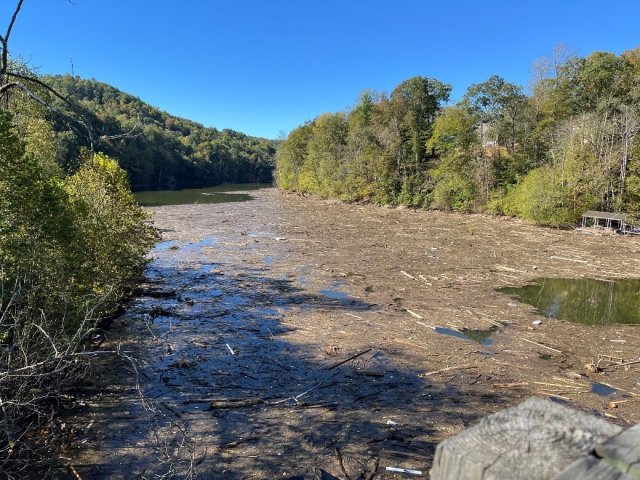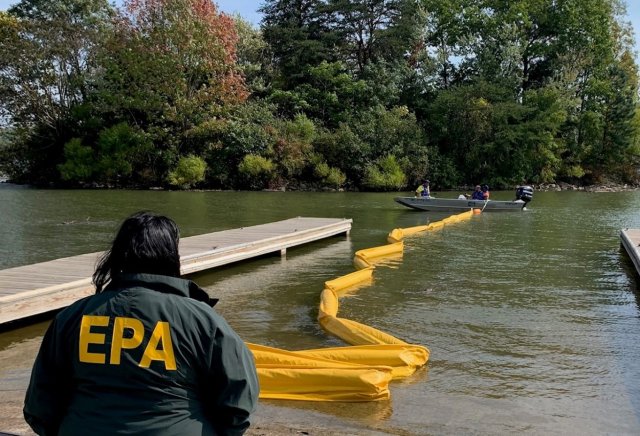Federal Agencies Working Together in Multimillion-Dollar Mission to Remove Debris in Virginia
BRISTOL, Va. (Oct. 16, 2024) — Tropical Storm Helene devastated communities throughout southwestern Virginia. Since then, federal agencies have been working with Commonwealth and local partners to address communities’ needs and help individuals on their journey to recovery. At the request of the Commonwealth, the Federal Emergency Management Agency (FEMA), the United States Army Corps of Engineers (USACE), and the Environmental Protection Agency (EPA) have announced a multimillion-dollar commitment dedicated to removal of debris in and around Claytor Lake State Park and the South Holston Lake Area, which were impacted by Tropical Storm Helene.
Alongside rain, tornados, wind and flooding, Tropical Storm Helene left debris on land and in waterways. Lakes in Virginia are a source of drinking water, provide power through hydropower dams, serve as recreation sites for boating and fishing and support many species of wildlife.
A significant amount of debris, including woody debris, boats, propane and fuel tanks, and pieces of structures litter Claytor Lake State Park and the South Holston Lake Area, threatening critical functions of the parks and waterways. Boating, kayaking, swimming and fishing are not currently possible at Claytor Lake State Park because of debris in the water and on the park shoreline.

Due to the extent of debris, the Commonwealth has requested support for debris removal. In support of the Commonwealth of Virginia’s request, as directed by and in coordination with FEMA, the Environmental Protection Agency (EPA) and U.S. Army Corps of Engineers (USACE) will be removing debris from public property in the South Holston area and on Claytor Lake to reduce threats to public health and safety.
This is the largest debris mission in Virginia since 2003 and will last for over three months. “This debris mission shows the full federal family’s commitment to Virginia communities,” said FEMA Federal Coordinating Officer Timothy Pheil. “Recovery cannot be achieved alone, with one program or one agency. I am grateful to the Commonwealth and to our federal partners for responding to the needs of the whole community.”
The Army Corps of Engineers will be taking on the multimillion-dollar mission, which includes waterway debris removal for Claytor Lake and South Holston River at South Fork. USACE crews began land and water debris assessment Oct. 4, and continue providing assistance to the Virginia debris task force. The USACE contractor will mobilize and begin removing debris next week. USACE estimates the work could take about 120 days to complete.
The waterway debris removal presents unique challenges for the USACE team. Crews will operate heavy equipment from land and afloat on barges to collect the debris, moving it to land for sorting and disposal. USACE debris specialists estimate up to 300 acres of debris in the two waterways.
“Debris removal on the water is inherently more complex,” said Col. Sonny Avichal, commander of USACE’s Norfolk District, “and our first priority is ensuring the safety of the public and our teams. We’re working together toward the same goal, so we also want to make sure we’re talking with the communities frequently to share information and listen to concerns.”
EPA’s first responders have been at the site assisting federal and state agencies since Sept. 29, and received federal approval to begin oil and hazardous material cleanup on Oct. 6. The EPA’s mission in the debris removal efforts includes assessing and cleaning up hazardous material, white goods, and oil across the entire impacted area to ensure human health and the environment is protected.
"A person’s safety is always our top priority, especially following a natural disaster like Hurricane Helene," said EPA Mid-Atlantic Regional Administrator Adam Ortiz. "We are incredibly proud of our first responders who are working tirelessly along with our local, state and federal partners to remove hazardous materials and protect drinking water that our communities depend on. We are committed to ensuring affected families in the Commonwealth have the support and resources they need to move forward.”

The debris mission does not include private property. If residents have household hazardous materials or oil containers that were damaged by the storm, they can be brought to 919 S. Shady Avenue in Damascus, Va. seven days a week from 9 a.m. to 5 p.m. Find resources for residents and business owners, including tips for staying safe and information on agencies that can help here: 9 Ways to Stay Safe Cleaning Up Debris After a Disaster | FEMA.gov.
For more information on Virginia’s disaster recovery, visit vaemergency.gov, the Virginia Department of Emergency Management Facebook page , fema.gov/disaster/4831 and facebook.com/FEMA.
